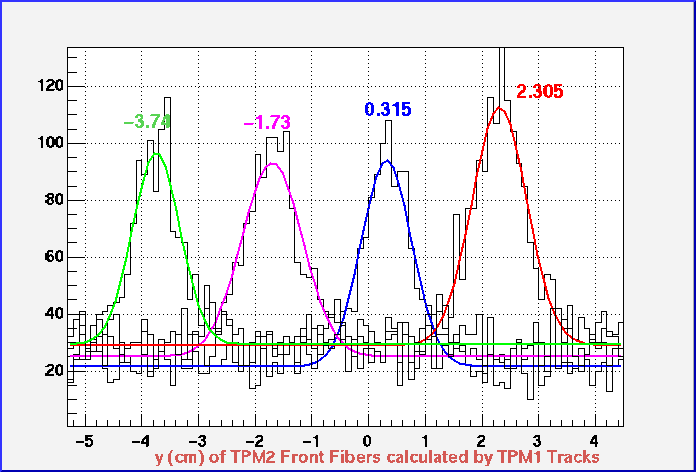- Previous message: J.H. Lee: "More on the Drift Velocities"
- In reply to: Trine S. Tveter: "RE: Drift Velocty Variations of TPM"
- Next in thread: Flemming Videbaek: "Re: TPM1 Drift Velocity (Re: Drift Velocty Variations of TPM)"
- Reply: Flemming Videbaek: "Re: TPM1 Drift Velocity (Re: Drift Velocty Variations of TPM)"
- Messages sorted by: [ date ] [ thread ] [ subject ] [ author ]
Dear Trine and Others, Probably what we have to do for calibrating the TPM1 drift velocity is parameterize some of the observables you've mentioned with the measured DVM values, and then we can use either values for the drift velocity. Projecting TPM1 tracks to Fibers might be a little bit tricky for the most of the physics runs since there is a vertical focusing effect due to the magnetic field. But one of the possibilities is that we use TPM2 Fiber information in zero-field runs, and comapare the measured positions of TPM1 tracks in the Fibers with the DVM values to get a scale factor (hopefully it's a constant). Then it's just drift velocity = DVM value*scale factor. Here is a y distribution of the TPM1 tracks projected to the Fibers on the front of TPM2 for the run 5823 (D5=0). The measured distances (integrated over x) between two Fibers are consistent with the physical separations (2 cm) for this run, Fiber2-Fiber3 = 2.305-0.315 = 1.99 cm Fiber3-Fiber4 = 0.315+1.73 = 2.045 cm Fiber4-Fiber5 = -1.73+3.74 = 2.01 cm, which means that the TPM1 drift velocity we used (1.7) is correct for this particular run. I'm looking at some more Fiber data from zero-field runs, which we don't have much, with DVM values to see if we can just scale them with a constant factor. JH > Dear JH, Ian and others, > ... > Also what's the most efficient / reliable way to determine it for TPM1 > which doesn't have fibres? Is it safe to assume proportionality to > the TPM2 variations (or DVM runs) or should one do more careful studies > of track intersection with beam plane and TPM2 fibres, MRS track match > parameters, bottomcluster positions etc. etc. .... > ... > Trine

- Next message: Flemming Videbaek: "fromuling physicist -- the sche This weekend"
- Previous message: J.H. Lee: "More on the Drift Velocities"
- In reply to: Trine S. Tveter: "RE: Drift Velocty Variations of TPM"
- Next in thread: Flemming Videbaek: "Re: TPM1 Drift Velocity (Re: Drift Velocty Variations of TPM)"
- Reply: Flemming Videbaek: "Re: TPM1 Drift Velocity (Re: Drift Velocty Variations of TPM)"
- Messages sorted by: [ date ] [ thread ] [ subject ] [ author ]
This archive was generated by hypermail 2b30 : Fri Dec 14 2001 - 15:44:22 EST